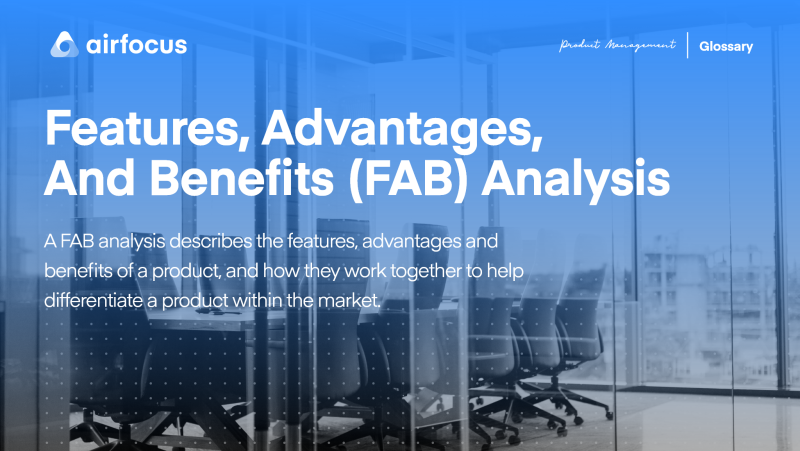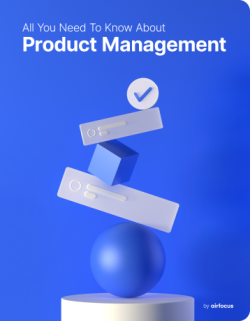Features, Advantages and Benefits (FAB) Analysis
What is a features, advantages, and benefits analysis (FAB) ?
Definition of features, advantages and benefits analysis (FAB)
A FAB analysis describes the features, advantages and benefits of a product, and how they work together to help differentiate a product within the market.
Features are easily defined as we can see or use them, but how they translate to an eventual benefit to a user can be more difficult to determine.
However, it�’s important to understand what benefits users get because ultimately, it’s the benefits — not features — that drive purchase decisions.
Put simply: features create advantages, and advantages bring benefits to a customer.
That is why it is important for sales and marketing teams to write a FAB statement to bring these elements together.
Let’s break down the distinction:
Features
These are characteristics that a product or service has. It is a simple statement about attributes.
For example: ‘An automated photo storage app that edits, selects and stores photos’
Advantages
An advantage is what that feature does, and how it helps. These are factual and descriptive but do not yet make a connection as to how it will make users' life better.
For example: 'It automatically keeps only the clearest picture of a similar set, and deletes the rest. Your photo storage is reduced on average by 80%.
Benefits
A benefit is the result of that advantage, and it is why a prospect would ultimately use a product.
This key benefit provides an emotional hook point that you can leverage in helping the user imagine the positive experiences felt by using your product.
For example: 'If you don’t waste your time editing and can store more of your best photos, you’ll keep happier memories for longer'.
So in this case, our example FAB statement will look something like this:
“We are an automated photo storage app that edits, selects, and stores photos. By keeping only the clearest picture of a similar set, and deleting the rest, your photo storage is reduced on average by 80%. If you don’t waste your time editing and can store more of your best photos, you’ll keep happier memories for longer!”
The difference between features and benefits
To build a good connection with their customers, companies need to communicate both the features and the benefits of their service or product.
But what’s the difference?
Features refer to what the product or service specifically does and how it is different from what the competition does.
Benefits, on the other hand, describe the reasons why the features matter to the audience. Most of the time, benefits are the reasons why customers feel compelled to buy a product.
Software features and benefits examples
Let’s look at some marketing messaging examples from a benefit and a feature point of view.
1. Slack
Features: Allows teams and team members to communicate via text messages, video calling, and audio huddles. Integrates with many different services like GSuite, GIPHY, and more.
Benefits: Streamlines communication between teams and keeps communications all in one place, saving time.
2. Square
Features: Send receipts via email or text message, send invoices for free, set up recurring payments, track sales by different metrics, and collect private customer feedback from digital receipts.
Benefits: Save money and time by using an app for all your banking needs.
3. The original iPod
Features: includes 5 GB of storage on a hard drive, a 60-mW output amplifier, a FireWire port for syncing with a computer, a standard 3.5-mm headphone jack, a scroll wheel and button interface
Benefits: Take 1,000 songs in MP3 format with you anywhere you go in a small, easy-to-carry device.
4. Hello Fresh
Features: a meal kit delivered to your door with pre-measured high-quality ingredients, easy-to-follow recipes, the ability to customize your meal based on your dietary preferences and the needed number of portions
Benefits: You reduce waste by receiving just the amount of ingredients you need, you save money by cooking instead of going out, and you save time by not having to go the grocery store
How to use a FAB analysis in product management with an example
We use FAB analysis to evaluate a product's features, advantages, and benefits to understand its value proposition and unique selling points. Here's how FAB analysis works in product management:
Features: Identify the features of your product, which are the specific attributes that define its functionality. For example, if you’re developing a smartphone, key features would be an OLED screen, a high-resolution camera, and long battery life.
Advantages: To determine the advantages of each feature, identify the positive outcomes or benefits the customer receives from using them. List one to three advantages to gain a holistic understanding of each feature. So, we could list the advantages of the OLED screen for the smartphone. This also helps you prioritize features.
Benefits: Identify the overall benefits of the product, which are the ultimate value that the customer receives from using it. Again, try to write down one to three benefits. In our smartphone example, benefits include all-day connectivity, perfect pictures, and a better media viewing experience.
Example of a FAB analysis
To help you get a better picture of how FAB analysis works, let’s look at how Slack shapes up.
Features:
Enables team communication using text messages, video calls, and audio huddles.
Offers users the ability to set up channels to help with focus and organization.
Packed with various automation to help streamline communication
Plenty of integrations to help fit into existing workflows
Advantages:
Puts teams in control of how they communicate
Helps users search and find information quickly
Automated workflows for simplicity and convenience
Integrations let teams do everything in one app
Benefits
Businesses waste less time with communication issues
Streamlined communication and workflow
Integrating with existing workflows means reduced costs
Why use a FAB analysis?
FAB by name, fab by nature. FAB analysis allows product managers to better understand a product, whether they’re assessing the competition or looking to improve upon their previous work.
FAB analysis helps identify the key features of a product or service and how they can benefit customers. This allows businesses to focus on highlighting the most features that are most important to customers and helps differentiate their products from competitors.
FAB analysis can also help businesses better communicate with their customers by using language that resonates with them. FAB analysis focuses on the benefits that a customer can gain from using a product or service. This helps customers understand how a product or service can meet their needs, creating a stronger emotional connection with potential customers, and leading to increased sales and customer loyalty.
Improved customer communication also helps bolster marketing efforts. The back and forth between customer and business helps uncover unique insights about which features your customers actually use, what they need, and what they can do without. These insights can then be funneled into marketing strategies, focusing on the highlights to attract new customers.

General FAQ

Glossary categories
Experience the new way of doing product management

Experience the new way of doing product management








